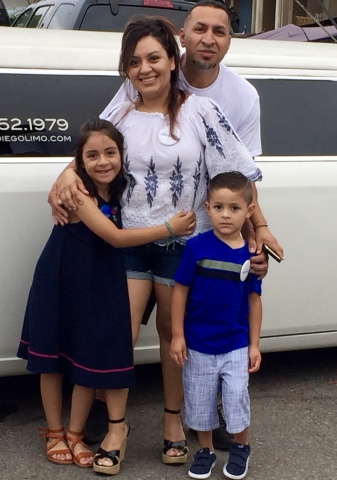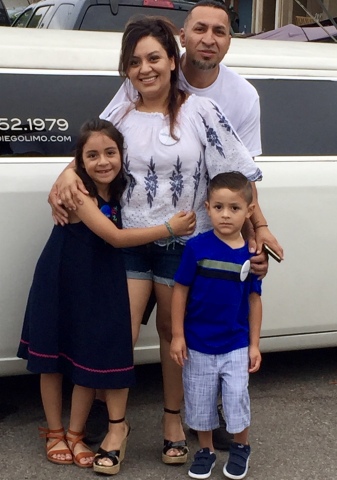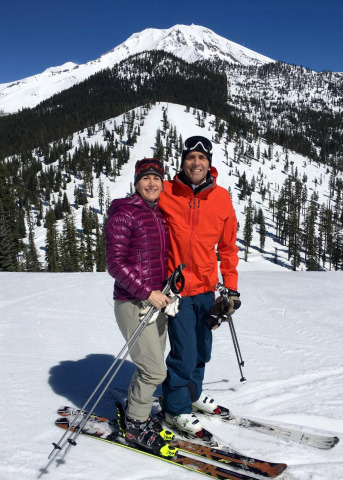DUARTE, Calif.--(BUSINESS WIRE)--Zuleika Flores was only 5 years old when she started to feel a lot of pain in her ankles. Small dots of blood had formed there, and underneath her eyes.
“She never cried but she was crying a lot one day from the pain,” recalled Luciana Flores, 38, Zuleika’s mother and a San Diego resident. “So we took her to the emergency room.”
After a few hours and several tests, an emergency room doctor told Flores: “I don’t want to tell you this, but I have to: Your daughter has leukemia.” Bleeding under the skin, a leukemia symptom, was causing the red dots. Zuleika started chemotherapy just a few days later, and was eventually diagnosed with a rare and aggressive cancer, Philadelphia chromosome-positive acute lymphoblastic leukemia. She would need a bone marrow transplant to survive.
On July 22, 2016, at City of Hope, Zuleika received bone marrow from a donor she had never met, Rosendo Moreno. The corrections officer, who lived nearly 1,700 miles away in Harvard, Illinois, had signed up for the Be The Match bone marrow registry seven years before Zuleika was even born.
“She would not be here today without (her donor),” Flores said as she paused to hold back tears. “I thank God for him, for the doctors, the nurses, everyone who helped her. She is healthy now. I know I will see her grow up.”
Nearly three years after Zuleika’s transplant, the Flores family will finally get the chance to thank Moreno for his selflessness at City of Hope’s 43rd annual Bone Marrow Transplant (BMT) Reunion on Friday, May 10, at a 10 a.m. news conference. The event takes place in the Argyros Family Garden of Hope, located in front of City of Hope Helford Clinical Research Hospital.
“Our BMT reunion is one of the brightest moments each year at City of Hope because it brings together thousands of patients, their families and their donors and our staff to celebrate a second chance at life,” said Stephen J. Forman, M.D., Francis & Kathleen McNamara Distinguished Chair in Hematology and Hematopoietic Cell Transplantation at City of Hope and leader of City of Hope’s Hematologic Malignancies and Stem Cell Transplantation Institute. “We honor our patients’ courage, our donors’ generosity, and our physicians, nurses and other medical staff’s dedication to helping our patients heal so that they may enjoy many more of life’s joys with their family and friends.”
“City of Hope’s leading-edge research is also celebrated at the reunion as it has helped to increase the number of blood cancer patients who can receive a bone marrow transplant, improve the procedure’s effectiveness and diminish its side effects,” Forman added.
City of Hope BMT patient Leif Voeltz, who will also meet his donor at the reunion, felt the impact of the institution’s focus on expanding BMT for patients; City of Hope was one of the first cancer centers nationwide to perform transplants on patients over the age of 50 using an approach to harness the donor’s immunity to help cure the disease.
For several months in 2014, Voeltz, an avid skier, bicyclist and climber, had been feeling tired. But he thought it was because he was getting older or fighting a severe flu. Finally, in August of that year, he went to a local emergency room. He looked so weak that a nurse immediately took his vital signs. His blood pressure had dropped, and he fell into a coma that lasted nine days.
During that time, Lacy Voeltz, his wife, received a devastating prognosis. A doctor told her Leif’s acute myeloid leukemia (AML) was so advanced that he likely only had a 5% chance of surviving.
For nine days, Leif Voeltz, then 63, of Mount Shasta, California, laid in a coma spurred by sepsis, a life-threatening condition that harms tissues and organs, with a high level of cancer cells.
“Our friends at home who are doctors were telling me, ‘You need to prepare because he’s not going to make it,’” Lacy said. “Every day, another one of his organs failed. He was on full life support. Once his liver started to fail, they lowered his chance of survival to under 2%.”
Leif received antibiotics intravenously for the sepsis and, despite how ill he was, he was treated with a reduced dose of chemotherapy. Doctors told the Voeltzes that because Leif is an athlete and didn’t suffer heart damage, he survived the coma and the treatment worked to achieve an initial remission. Leif became Forman’s patient at City of Hope in February 2015.
Leif’s cancer disappeared for only a few months before it returned and required more chemotherapy. Forman told him that the AML, despite his achieving a second remission, would likely return. Thus, he would need a transplant to hopefully prevent another recurrence and cure the disease. On Dec. 16, 2015, Leif received bone marrow-derived stem cells from a donor halfway around the world, Marcel Waldmann, 28, a resident of Germany. When Waldmann leaves Germany to meet Voeltz, it will be Waldmann’s first time flying and his first visit to the United States.
Adapting to the new bone marrow would prove difficult for Leif. While most transplant patients start generating white blood cells roughly two weeks after they’ve received the donor’s bone marrow, Leif did not. It took approximately 25 days for Leif to start producing white blood cells.
“Family, community and love,” is what the Voeltzes said got them through those difficult moments.
Leif, now 67 and the former owner of a mountain climbing and bike shop, received an overwhelming amount of support from their family and his small, close knit town of Mount Shasta, a picturesque, mountain town in Northern California with about 3,400 residents.
“The whole town got together and took a group photo, and sent the photos to us,” Lacy recalled. “There were pictures all over the walls that we put up of the love in the community and our family. Everywhere you looked, there were messages of encouragement.”
Like the Floreses, the Voeltzes also can’t wait to thank Leif’s donor.
“He’s a hero,” Lacy said. “How do you thank someone for saving your soulmate, the love of your life? I don’t know how to put that into words. I know how to put it into tears and that’s probably the best I’m going to be able to do.”
About City of Hope’s BMT program
City of Hope recently celebrated its 15,000th transplant, making it one of the largest and most successful programs in the nation. The institution has the most prodigious BMT program in California, performing over 700 transplants annually.
Over the years, City of Hope has also helped pioneer several BMT innovations. In addition to being one of the first institutions to perform BMTs in older adults, it was one of the first programs to show that BMTs could be safely performed for patients with HIV. City of Hope has had growing success with non-related matched donors and, most recently, half matched family donors.
City of Hope was also one of the first programs to develop a treatment for prevention of cytomegalovirus (CMV), a common and potentially deadly infection after transplant, which has nearly eliminated the threat of CMV for BMT patients. It is currently conducting clinical trials of a CMV vaccine that was developed at City of Hope. As a pioneer in the development of CAR T cells to treat cancer, City of Hope is also testing how this form of cancer immunotherapy can help patients have a more successful transplant.
For 14 consecutive years, City of Hope’s BMT program is the only one in the nation that has had one-year survival above the expected rate, based on analysis by the Center for International Blood and Marrow Transplant Research.
In addition, Be The Match at City of Hope each year adds more than 15,000 new donors, and more than 270,000 donors have joined the registry via City of Hope. To join the registry, visit Be The Match.
About City of Hope
City of Hope is an independent biomedical research and treatment center for cancer, diabetes and other life-threatening diseases. Founded in 1913, City of Hope is a leader in bone marrow transplantation and immunotherapy such as CAR T cell therapy. City of Hope’s translational research and personalized treatment protocols advance care throughout the world. Human synthetic insulin and numerous breakthrough cancer drugs are based on technology developed at the institution. A National Cancer Institute-designated comprehensive cancer center and a founding member of the National Comprehensive Cancer Network, City of Hope is ranked one of America's "Best Hospitals" in cancer by U.S. News & World Report. Its main campus is located near Los Angeles, with additional locations throughout Southern California. For more information about City of Hope, follow us on Facebook, Twitter, YouTube or Instagram.




